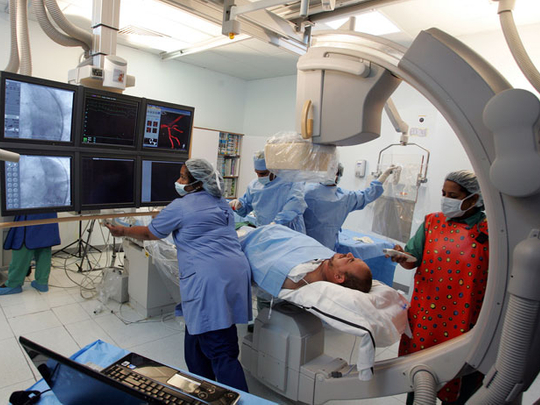
Dubai: It is time for health-care operators and investors to head for the city’s current outskirts and seek an early mover advantage as the resident base expands in those neighbourhoods, experts say.
With 71 per cent of the city’s existing health-care capacity based in highly saturated locations within ‘Old Dubai’, there would be a commercially competitive advantage from looking elsewhere.
The emergent opportunities for new hospitals or clinics would be in areas such as Mohammad Bin Zayed Road, Al Khail Road and along some of the newer locations on Shaikh Zayed Road, according to Colliers International. The consultancy estimates that the value of the ‘UAE’s private hospitals property reached $1.13 billion in 2007 and $1.39 billion in 2011. This is estimated to reach $2.83 billion by 2020’.
Much of the new investments could be in hitherto untapped locations. According to T.J. Wilson, CEO of Aster DM Healthcare, “There is a definite movement of resident populations towards the peripheral areas of the city, and they are peripheral for the foreseeable future as the city expands laterally in key directions.
“Health-care operators will have to follow with investments in the emerging areas, the likes of Silicon Oasis and residential clusters in that area rated as prime locations. Once they reach a certain resident size, today’s clinics can make way for general hospitals or speciality centres.”
In a way, health-care specific investments are catching up after a relatively low-key phase between 2009-2011.
They also need scaling up given the projections for the city’s resident base. Colliers International reckons the city’s population could cross 3.5 million in 2020, if the current growth pattern of 6.66 per cent compounded growth is maintained. Dubai had an estimated population of 2.2 million as of end 2013. “Should the projected growth rate increase to 8 per cent, due to various initiatives taken by Dubai recently, the expected population will reach 3.8 million in 2020.”
In comparison, overall bed capacity at hospitals in Dubai was estimated at 3,816 beds by end 2012 compared to 3,155 beds in 2008, a compounded growth rate of 4.9 per cent. Colliers International estimates the value of Dubai’s private hospitals at $430 million (Dh1.6 billion) in 2005 and $870 million in 2013.
It is anticipated to reach $1.62 billion by 2020.
In a statement, Mansoor Ahmad, Director of Healthcare, Education and PPP at Colliers International, said: “Dubai has one of the fastest population growth rates in the world coupled with rising wealth levels. Due to rapid urbanisation and unhealthy lifestyles of a large number of the population in Dubai, this has led to an increase in chronic diseases previously uncommon to the region.
“To further establish Dubai as a medical and wellness tourism hub, health-care providers could offer tailor-made comprehensive medical and wellness tourism packages which include costs of medical treatment, visa, hotel stays and even recreational activities for accompanying family members. If medical tourism in Dubai were to capture 2 per cent of its international tourists in 2015, an additional $1 billion in revenues would be generated by the health-care sector.”












